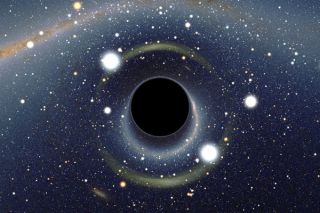Black holes are a region of spacetime that exhibits gravitational acceleration so strong that nothing, including light itself, can escape. The boundary of the black hole from which no light can escape is called the event horizon. Although the event horizon has an enormous effect on the fate and circumstances of an object crossing it, no locally detectable features can be observed by scientists. Therefore, it can be said that In many ways, a black hole acts like an ideal black body, as it reflects no light. The theory of general relativity does allow and indeed predicts that a sufficiently compact mass can deform spacetime to form a black hole.
Major Milestones
The first considerations of objects such as Black Holes, whose gravitational fields are too strong for light to escape were first considered in the 18th century by John Michell and Pierre-Simon Laplace. It was Albert Einstein who first predicted the existence of black holes in 1916, with his general theory of relativity; however, the first modern solution of general relativity that would characterize a black hole was performed by Karl Schwarzschild in 1916, Although a solution was found in 1916 using general relativity to characterize a black hole, the interpretation of said black hole as a region of space from which nothing can escape was first published by David Finkelstein in 1958.
The term “black hole” that is often associated with this phenomena was coined in 1967 by American astronomer John Wheeler. After decades of theoretical discussion, the objects known as black holes were first discovered in 1971. In 2019 the Event Horizon Telescope collaboration released the first image ever recorded of a black hole.
Formation And Interesting Properties
Conventional black holes are formed by gravitational collapse of heavy objects such as stars, but they can also form by other processes in theory.
Once a black hole has formed, it can continue to grow by absorbing additional matter. Any black hole will continually absorb gas and interstellar dust from its surroundings. This is the primary process through which supermassive black holes seem to have grown.
Predicted in 1974 by theoretical physicist Stephen Hawking, black holes do emit small amounts of thermal radiation and are not entirely black. By applying quantum field theory to a static black hole background, he determined that a black hole should emit particles that display a perfect black body spectrum. Since published, many other scientists have verified the result through various approaches. If Hawking’s theory of black hole radiation is correct, then black holes are expected to shrink and evaporate over time as they lose mass by the emission of photons and other particles.
Observational Evidence
Because light does not escape the event horizon, it is not possible to directly observe a black hole via visible telescope. Therefore, astronomers need to use additional ways such as gravity waves and the orbit of the material around the black hole. The article from SETI below provides a great way to get started.
https://www.seti.org/black-hole-observed-first-time-ever
Black Holes SubTypes
There are 3 types of black holes, which vary in size and are grouped by said size.
Stellar Black Holes
A stellar black hole, otherwise known as a stellar-mass black hole, is a black hole formed by the gravitational collapse of a star. These types of black holes have masses ranging from about 5 to 10s of solar masses. The creation process of stellar black holes is observed on Earth as a hypernova explosion or as a gamma ray burst. These stellar objects are also referred to as collapsars and are considered the smallest type of black hole.
Intermediate Black Holes
Intermediate-mass black holes were only recently thought possible with strongest evidence for IMBHs comes from a few low-luminosity active galactic nuclei.
Supermassive Black Holes
A supermassive black hole is the largest type of black hole, containing a mass of the order of hundreds of thousands to billions of times the mass of the Sun. Observational evidence indicates that nearly all large galaxies contain a supermassive black hole, which is located at the center of the galaxy. Scientists are unsure how these objects form and is an open area of scientific research.
Open Questions
- Entropy And Thermodynamics was first described in 1971 when Stephen Hawking showed under general conditions that the total area of the event horizons of any collection of classical black holes can never decrease, even if black holes collide and merge. This led to the creation of black hole thermodynamics, which is the area of study that seeks to reconcile the laws of thermodynamics with the existence of black-hole event horizons. This is important to rectify as to make sure that the loss of black hole mass through Hawking Radiation does not violate the 2nd law of thermodynamics.
- Information Loss Paradox is a result of black holes having limited amount of internal parameters, as most of the information about the matter that went into forming the black hole is lost. Regardless of the type of matter which goes into a black hole, scientists have noticed that it appears that only information concerning the total mass, charge, and angular momentum are conserved. The question whether information is truly lost in black holes has divided the theoretical physics community. In quantum mechanics, loss of information corresponds to the violation of vital property called unitarity, which has to do with the conservation of probability. It has been argued that loss of unitarity would also imply violation of conservation of energy. Over recent years evidence has been building that indeed information and unitarity are preserved in a full quantum gravitational treatment of the problem.
- The Firewall Paradox is a hypothetical phenomenon where an observer falling into a black hole encounters high-energy quanta at or near the event horizon. The use of a firewall to resolve this inconsistency remains controversial; however, it has been theorized as way to solve the particles that escape the black hole as Hawking Radiation.
Research And Further Reading
https://www.space.com/15421-black-holes-facts-formation-discovery-sdcmp.html
https://web.archive.org/web/20040925044354/http://www.mpe.mpg.de/ir/GC/index.php
https://www.esa.int/gsp/ACT/phy/Projects/Blackholes/WebGL.html

Leave a comment